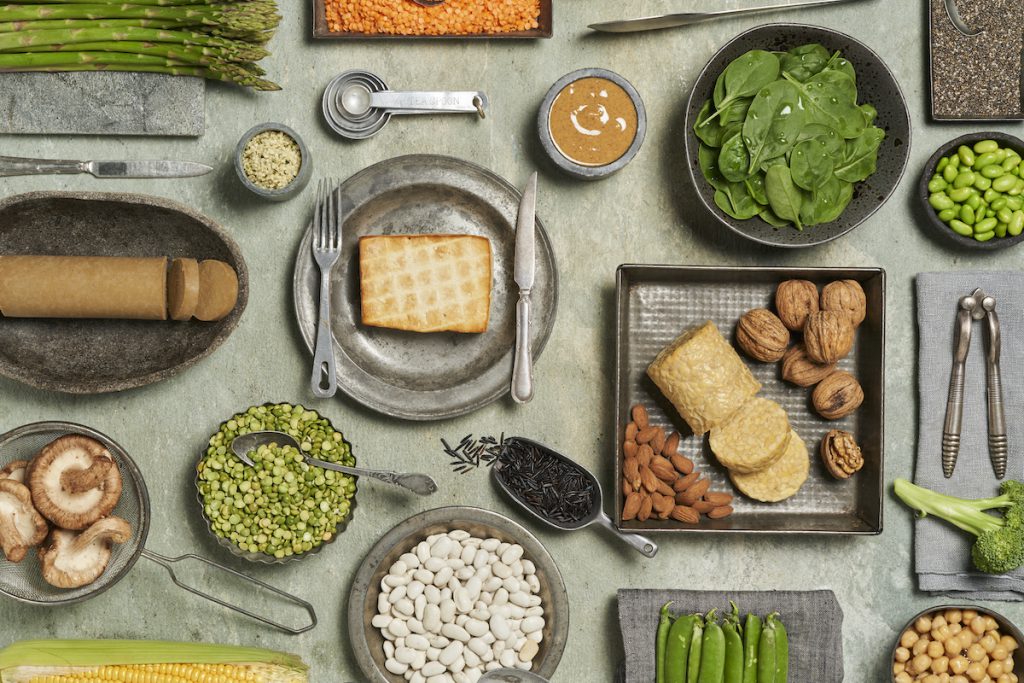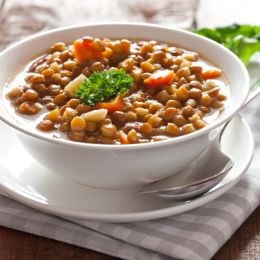Top 5 Plant-Based Sources of Protein for Older Adults
Most of us aren't eating enough of this muscle-building nutrient. Get your fill with these healthy sources.

When it comes to high-protein foods, chicken, eggs, and Greek yogurt often take the spotlight. But you don't have to lean on animal products to get your fill.
“Eating several servings of plant-based proteins every day can certainly help older adults meet their protein requirements,” says Taylor Wolfram, R.D.N. She’s a registered dietitian nutritionist in Chicago specializing in vegan nutrition. And that’s important, since eating enough protein is vital to staying healthy and independent in the long run.
But there’s new evidence that piling protein-packed plants onto your plate can come with extra health benefits, too.
For instance, a study in JAMA Internal Medicine found that replacing just 3 percent of calories from animal protein (think red meat or eggs) with a plant protein (like nuts or beans) lowered the participant’s risk of early death by 10 percent. While other research has found that plant-based diets can protect you against heart disease, diabetes and high blood pressure.
“Plants also deliver nutrients such as fiber and phytonutrients that you won’t get from animal proteins,” Wolfram says. These can help stave off disease and keep gut health on point. Plus, Wolfram adds, plant-based proteins tend to be low in saturated fat, which is good for heart health.
Even if you don’t want to go completely vegetarian or vegan, plant-based proteins deserve to be a bigger part of your diet. And these picks can give you the most protein bang for your buck — and can be easily worked into the meals you’re already making.
Plant-Protein Powerhouse #1: Split Peas
These humble legumes are far from a one-hit wonder. Sure, they pack 8 grams of protein per half cup. But they also give you about 8 grams of dietary fiber in that serving, too.
"Fiber helps reduce cholesterol and improves blood sugar management, which can impact heart and metabolic health," notes Wolfram. Men and women over the age of 50 should aim to consume 30 and 21 grams of fiber daily, respectively.
Another nutritional highlight of green and yellow split peas is lofty amounts of folate, which Wolfram says is vital for our DNA synthesis and metabolism.
In the Kitchen: Since the peas are split, they cook faster. (Plus, it eliminates the need for a pre-soak that’s needed to cook dried beans.) To get started, simmer one cup of split peas in two cups of water for about 25 minutes. Split peas can also be cooked in a slow cooker. Besides split pea soup and aromatic Indian dal dishes, use the peas to:
- Make dips like hummus
- Provide bulk to casseroles and veggie burgers
- Add protein to vegetable salads
Plant-Protein Powerhouse #2: Tempeh
While tofu is made from soymilk, tempeh is made from fermented soybeans. This gives it about double the protein (about 16 grams per half cup) and more flavor. “Tempeh has a mild, nutty, tangy taste, and a firm, ‘meaty’ texture that holds up well as a meat alternative,” says Sharon Palmer, R.D.N. She’s a registered dietitian nutritionist in Ojai, California, and author of California Vegan and The Plant-Powered Diet.
Tempeh is also rich in other nutrients (B vitamins, iron, and fiber, to name a few). Plus, since it's fermented, it tends to be easier to digest than beans, adds Palmer. Translation: less gas.
In the Kitchen: Tempeh soaks up flavors from sauces and spices very well. So, try marinating plain tempeh patties just as you would steak or chicken. Then you can grill, bake, or pan-fry to cook. Add your tempeh to salads, sandwiches and tacos. Or you can make ground tempeh using the large holes of a box grater and create meat-free versions of these dishes:
- Chilis
- Meatballs
- Burgers
- Kebabs
- Bolognese sauce
Plant-Protein Powerhouse #3: Peanut Butter
Peanuts are legumes just like split peas and beans. This means they boast a little more protein than other nut butters made with tree nuts (like almonds), says Palmer. In fact, they have about 7 grams of protein per 2-tablespoon serving.
Peanut butter is also a perfect mix of protein and healthy fats, which helps you stay fuller longer. “Combined, these two nutrients can help you avoid spikes in blood sugar after a meal,” says Palmer. This helps reduce your risk of diabetes — and the sugar crash that can bring on hunger pangs, adds Palmer.
To get the most benefit, select a peanut butter that doesn’t include any added sugar or added fats, such as palm oil.
Suscríbase a nuestro boletín informativo
Es rápido y fácil: Usted podría estar entre las 13 millones de personas elegibles.
¿Ya es miembro? Haga clic para descubrir nuestros más de 15,000 centros participantes.
Síganos
In the Kitchen: Peanut butter is a perfect grab-and-go protein source. Put some on toast with sliced bananas for a quick snack, use it as a dip for apple slices, or add a dollop to your morning yogurt. It also makes a great add-on to smoothies, oatmeal, and creamy sauces for stir-frys.
Plant-Protein Powerhouse #4: Hemp Seeds
Tiny but mighty, hemp seeds have nearly 10 grams of protein in a 3-tablespoon serving. But that's not all. They also contain all nine essential amino acids that your body can only get from food (a key part of keeping muscle mass as we age). And they're a good source of the healthy fats called omega-3 fat alpha-linolenic acid (ALA). "ALA has been linked to lowering inflammation which can have heart health benefits," says Palmer.
In the Kitchen: Hemp seeds taste like a cross between pint nuts and sunflower seeds. (And don't worry - they won't get you high like a marijuana plant.) For a boost of nutrition and flavor, you can blend hemp seeds into dips and smoothies, or sprinkle them on:
- Oatmeal
- Yogurt
- Salads
- Soups
- Roasted vegetables
Plant-Protein Powerhouse #5: Chickpea Pasta
No shade to regular pasta, but noodles made from chickpeas and other legumes can give you a notable protein and fiber boost, says Wolfram. A 2-ounce serving of chickpea-based pasta supplies about 11 grams of protein and 6 grams of fiber. That’s nearly twice as much protein and three times as much fiber as traditional pasta made from wheat flour.
Boil up a pot of chickpea penne or rotini and you’ll also get more of several vital nutrients such as magnesium, iron, and potassium.
In the Kitchen: These new-generation noodles have definitely improved in flavor and texture over the years. But there are a couple of important things to keep in mind when preparing any legume-based pasta.
- These pastas can go from perfectly al dente to soggy in a matter of moments. So, taste test often as you near the recommended cooking time.
- The noodles also foam quite a bit when in boiling water, so skim it off as needed with a spoon.
- Unlike wheat-based noodles, the legume variety should be rinsed with cold water after draining to remove the starch.
¡Tome en línea sus clases favoritas de SilverSneakers!
SilverSneakers members can access live fitness classes and wellness workshops through SilverSneakers LIVE. See the latest schedule and RSVP for classes here.
Not a member? If you have a Medicare Plan, it may include SilverSneakers — at no additional cost. Verifique su elegibilidad al instante aquí.





